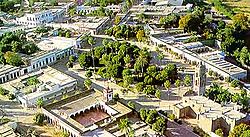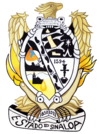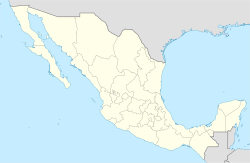Mocorito facts for kids
Quick facts for kids
Mocorito, Sinaloa, Mexico
|
||
|---|---|---|
 |
||
|
||
| Nickname(s):
La Atenas de Sinaloa
|
||
| Country | ||
| State | Sinaloa | |
| Municipality | Mocorito | |
| Founded in | 1594 | |
| Area
4.4%
|
||
| • Land | 2,566 km2 (991 sq mi) | |
| Population
(2020)
|
||
| • Total | 5,926 | |
| Time zone | UTC-7 (Mountain Standard Time) | |
| • Summer (DST) | UTC-6 (Mountain Daylight Time) | |
| Website | Mocorito Government page | |
Mocorito is a town in the Mexican state of Sinaloa. It's the main town, or "municipality seat," of the Mocorito Municipality. In 2020, about 5,926 people lived there. The name Mocorito comes from the Cáhita language. It means "place where people speak macuri," which is a dialect of the Mayo language. Some also say it means "place of the dead."
Contents
The First People of Mocorito
Before the Spanish arrived, a group of tribes called the Cáhita lived here. They had permanent villages along rivers like the Mocorito, Sinaloa, and Fuerte. The Cáhitan people spoke a language related to Pima and Cora.
What Does the Name Mocorito Mean?
The name Mocorito has a cool history!
- Professor Héctor R. Olea says it comes from "macori-to." "Macuri" refers to the Mayo Indians or people who spoke a certain dialect of the Cáhita language. The "to" part means "place." So, it means "place where people speak a Cáhita dialect" or "where the Mayo Indians live."
- Other historians, like Mr. Eustaquio Buelna, think Mocorito means "place of the dead."
Mocorito's Past: A Quick Look
Early Days and Spanish Arrival
In 1531, a Spanish explorer named Nuño de Guzmán came to northwest Mexico. He founded a town called San Miguel de Navito. This started the mapping of the Culiacán area. A year later, Sebastián de Evora explored the Mocorito valley. He named the town and river after himself.
In 1594, two Jesuits, Juan Bautista Velasco and Hernando de Santarán, started the Mocorito Mission. This was an important religious center.
How Mocorito Became a Municipality
By 1732, the Spanish had expanded a lot. The land was divided into provinces. Sinaloa and Sonora became one big area with its capital in San Felipe and Santiago de Sinaloa.
Later, in 1749, the area was divided into five provinces. Mocorito was part of the Culiacán area.
In 1813, a new law called the Constitution of Cádiz said that towns with more than 1,000 people could have their own local governments, called municipalities. This law was stopped for a bit but came back in 1820. That's when the first municipalities in Sinaloa were created.
In 1824, the states of Sonora and Sinaloa joined to form the Estado de Occidente. Mocorito was part of the Culiacán region within this new state.
Finally, in 1830, Sonora and Sinaloa became separate states. Sinaloa was divided into eleven districts, and Mocorito became one of them! It was officially made a Municipality on April 8, 1915. Over the years, Mocorito's size changed a bit as new municipalities were formed nearby.
The Meaning Behind the Coat of Arms
Mocorito has its own special coat of arms, created in 1964. It's shaped like an oval and divided into four parts.
- The border is made of stone, showing respect for the native people who didn't use metal. It has footprints that symbolize the journey of the Nahuatl people who settled in Sinaloa.
- The top left part has a black background, representing the ancient past.
- The top right part shows the start of Mocorito's history. It has a small building by the Sinaloa River and a road crossing the Mocorito River. The path leads to a larger building, which stands for the city of San Miguel de Culiacán.
- The bottom right section has a silver background with a native-style church and the date 1594. This marks the founding of the Mocorito mission.
- The bottom left section has a gold background. It shows the current church and an orange drop from a hill, symbolizing gold mining.
- Outside the oval, there's a flame-like design for patriotic movements. An open book with dates 1857-1917 represents important constitutions. A bronze eagle holds a banner that says "Estado de Sinaloa" (State of Sinaloa), showing it's part of the nation.
Fun Culture and Traditions
Carnival Celebrations
Mocorito has a lively carnival! It's a time for fun and celebration.
- On the first day, people gather to find out who will be "burned" (a symbolic figure).
- The second day is when the Queen of the Floral Games is crowned.
- On the third day, the Carnival Queen gets her crown.
- Sunday features the first parade with colorful floats and music bands.
- Monday is for crowning the Children's Kings and their float ride.
- The carnival ends on Tuesday with a big parade, awards for the best floats and bands, and a huge dance party!
Mocorito's Music Scene
Music is a big part of Mocorito's traditions. José Rubio Quinonez was a famous person who helped promote Sinaloa's popular band music. The band "Los Hermanos Rubio Mocorito" has traveled all over Mexico, playing lively drum music. Some of their famous songs include "The Lost Child," "El Toro Viejo," and "Brisas de Mocorito."
Famous People and Artists from Mocorito
Mocorito was once called "The Athens of Sinaloa" because it's known for its many talented artists.
- The famous muralist David Alfaro Siqueiros remembered Mocorito as a place where revolutionary forces gathered.
- Jose Ramon Velazquez was a writer who collected stories and facts about Mocorito from local people.
- Hector Lopez Gamez was a painter from Mocorito. He loved painting people, landscapes, and surreal art.
- Ernesto Rios, another painter and muralist from Mocorito, started by painting portraits. Later, he became famous for his murals, which you can see in places like Revolution Park in Culiacán.
- Dr. Enrique Peña Gutierrez was a doctor, poet, and writer. He also worked in farming and created a special fertilizer.
- Dr. Jose Dominguez Law was a doctor and a kind person who cared a lot about his town. He helped bring electricity and a water system to Mocorito. He also helped get a high school recognized and set up a health center.
Mocorito's People: Demographics
Population Details
Here's a look at the people living in Mocorito in 2020:
| Population | 2020 |
|---|---|
| Women | 3,043 |
| Men | 2,883 |
| Ages 0-14 | 1,368 |
| Ages 15-29 | 1,354 |
| Ages 30-59 | 2,125 |
| Ages 60+ | 1,078 |
| Disabled population | 340 |
| Total Population | 5,926 |
Religions in Mocorito
Here's a look at the different religions in Mocorito in 2020:
| Population | 2020 |
|---|---|
| Roman Catholic | 5,137 |
| Protestant | 332 |
| No Religion | 452 |
Mocorito's Natural World
Plants and Animals
Mocorito has three main climate zones: a tropical area in the west, mountains in the east, and a mix in the middle.
- Plants: In the high mountains, you'll find pine and oak trees. Lower down, there are amapas, ebony, cedars, and junipers. Near the coast, you'll see shrubs and herbs like mangroves, guamuchileros, mesquite, and wild figs.
- Farming: Farmers grow crops like rice, soybeans, corn, beans, and sugarcane. They also grow fruits such as cantaloupe, watermelon, mango, and oranges.
- Animals: Common farm animals include cattle, pigs, goats, and sheep. In the wild, you might spot deer, hares, rabbits, armadillos, and iguanas. In the deepest mountain areas, there are wild cats, and even tigers and lions (though these are very rare and usually refers to jaguars and pumas in Mexico).
Mocorito's Climate
Mocorito has a warm climate. Here's a summary of the weather:
| Climate data for Mocorito (1951–2010) | |||||||||||||
|---|---|---|---|---|---|---|---|---|---|---|---|---|---|
| Month | Jan | Feb | Mar | Apr | May | Jun | Jul | Aug | Sep | Oct | Nov | Dec | Year |
| Record high °C (°F) | 39.0 (102.2) |
38.0 (100.4) |
38.5 (101.3) |
42.5 (108.5) |
44.0 (111.2) |
45.0 (113.0) |
43.5 (110.3) |
42.0 (107.6) |
42.0 (107.6) |
42.0 (107.6) |
39.5 (103.1) |
35.5 (95.9) |
45.0 (113.0) |
| Mean daily maximum °C (°F) | 26.9 (80.4) |
28.6 (83.5) |
31.2 (88.2) |
34.3 (93.7) |
37.0 (98.6) |
38.0 (100.4) |
36.1 (97.0) |
35.0 (95.0) |
34.7 (94.5) |
33.8 (92.8) |
30.9 (87.6) |
27.4 (81.3) |
32.8 (91.0) |
| Daily mean °C (°F) | 18.6 (65.5) |
19.6 (67.3) |
21.3 (70.3) |
24.1 (75.4) |
27.3 (81.1) |
30.7 (87.3) |
30.2 (86.4) |
29.3 (84.7) |
29.0 (84.2) |
27.0 (80.6) |
23.0 (73.4) |
19.4 (66.9) |
25.0 (77.0) |
| Mean daily minimum °C (°F) | 10.4 (50.7) |
10.6 (51.1) |
11.5 (52.7) |
13.8 (56.8) |
17.5 (63.5) |
23.3 (73.9) |
24.3 (75.7) |
23.6 (74.5) |
23.3 (73.9) |
20.2 (68.4) |
15.0 (59.0) |
11.3 (52.3) |
17.1 (62.8) |
| Record low °C (°F) | 1.5 (34.7) |
−4.0 (24.8) |
3.0 (37.4) |
5.5 (41.9) |
9.0 (48.2) |
12.0 (53.6) |
14.0 (57.2) |
8.0 (46.4) |
11.0 (51.8) |
5.5 (41.9) |
6.0 (42.8) |
2.0 (35.6) |
−4.0 (24.8) |
| Average precipitation mm (inches) | 25.4 (1.00) |
12.6 (0.50) |
3.9 (0.15) |
1.4 (0.06) |
2.3 (0.09) |
28.0 (1.10) |
178.2 (7.02) |
198.9 (7.83) |
125.6 (4.94) |
50.6 (1.99) |
25.8 (1.02) |
23.3 (0.92) |
676.0 (26.61) |
| Average precipitation days (≥ 0.1 mm) | 2.5 | 1.5 | 0.7 | 0.2 | 0.3 | 2.8 | 13.2 | 14.3 | 9.2 | 3.5 | 1.8 | 2.4 | 52.4 |
| Source: Servicio Meteorologico Nacional | |||||||||||||
Famous People from Mocorito
- Los Tigres Del Norte - A very popular band!
See Also
 In Spanish: Mocorito para niños
In Spanish: Mocorito para niños




